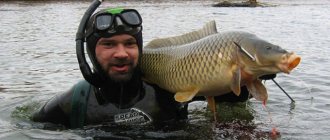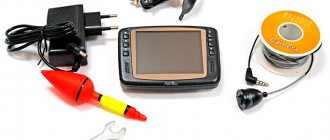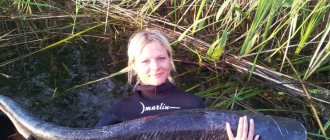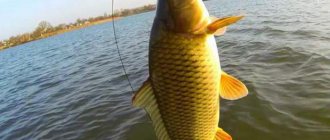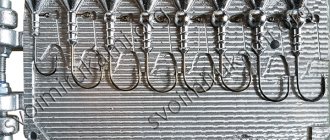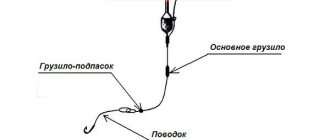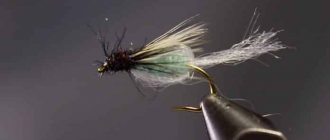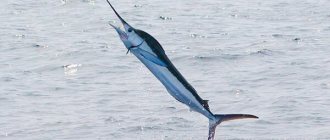What's good about spearfishing?
The smooth, mirror-like surface of the Dnieper is only occasionally disturbed by diverging circles in the water from frolicking fish. At some point, something round with horns appears from the depths. Like a floating mine. The object is moving towards the shore. The figure of a smiling young man in a “horned” mask and glasses reminiscent of a porthole gradually emerges. He swims towards the shore, making sweeping movements with his arms.
A diver comes to land. He is wearing swimming trunks and thick rubber flippers that resemble frog legs. On his hands are webbed gloves - they contain an almost meter-long aluminum tube, which at first glance you involuntarily mistake for a pistol. After a short time, the person will disappear under water again. And after 10-15 minutes he will swim out again, this time with prey in his hands.
This is what the first divers of the USSR looked like. This is how Komsomolskaya Pravda described them in 1955.
Safety
Before diving, you should study the safety rules; these unspoken laws have saved many lives. To avoid injury and be confident in your actions, you must:
- Work out with a partner or in groups.
- Do not stay in water for a long time while holding your breath.
- The rest time after a dive should be twice as long as being underwater.
- Before shooting, you need to make sure that the target is clearly visible; do not shoot at blurry silhouettes.
- Bring the gun to its original position and the shot itself is carried out only in water.
- Aiming at a person on land or in water is unacceptable.
- Weapons should be kept away from children.
- Release from the weight belt is carried out only after making sure that there are no obstacles to ascent.
Immediately after the shot, you should not rush to the trophy, wait a little, let the fish calm down.
The emergence of interest in a young sport
In the second half of the 20th century, underwater fishing began to develop abroad, which in essence is more reminiscent of hunting. The main distribution areas are the coasts of California and the Mediterranean Sea. The first clubs for underwater hunters opened in Italy, France, North America, and Australia. On the basis of these organizations, thematic literature is published, competitions and competitions are held.
As of 1955, there were nearly 50 thousand spearfishing enthusiasts in England. And at the beginning of 1956, interest in the depths reached the USSR, when the color documentary “20 minutes under water” produced in France was shown in cinemas. Viewers had the opportunity to take a fascinating journey into the depths. Most of the footage told about rocks, algae of unprecedented shapes and colors, evidence of ancient shipwrecks that keep their secrets. But the main thing that the film told about is that this unprecedented world is accessible to almost everyone.
The meaning of the sport
Despite the fact that this activity is predominantly amateur, it is of great importance for science. Experience has shown that ichthyologists often collaborate with underwater hunters to exchange information. This allows for more careful observations and study of the underwater world from a practical point of view. Our country is rich in natural resources, so such research assistance is very important.
The first underwater fishermen worked on the Dnieper. Previously, this sport was mainly of interest to young people, but now older people are also paying attention to it.
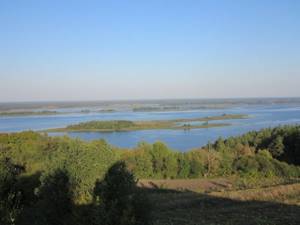
Spearfishing is important for strengthening the body and spirit. The athlete has to sit in ambush, conduct reconnaissance, look for prey, and make accurate shots. And sometimes engage in battle with aquatic predators. Certain skills required:
- swimming;
- diving;
- ability to control breathing;
- shooting.
Every skill develops with practice, but a hunter must have a “base” to begin with. Subsequently, dexterity, observation, determination, and speed of reaction are cultivated in him.
The equipment with which the fisherman goes to the depths is also important.
Equipment and equipment
Having discovered potential prey, the hunter hits it with a special gun. The weapon shoots harpoons that dig into the body of the fish. The tackle is attached to the line, which, in turn, is wound onto the reel. In this way, the fish can be attracted to you.
The required set of equipment is simple. This is a mask with a respirator (previously self-contained helmets were used), a special suit, a compressed air cylinder, fin fins, a gun, a supply of harpoons and bowstrings. Foreign hunters take with them some auxiliary devices:
- belts with pockets and carabiners;
- shotgun loaders;
- special daggers, knives, kukans;
- watches and compasses in waterproof cases;
- echo sounder;
- depth gauge..
For safety, special suits, vests are required (they make it possible to instantly discard equipment in a critical situation), rescue shoulder pads, which are filled with carbon dioxide from ampoules in the event of an accident, and more.
Let's take a closer look at individual types of equipment.

Safety precautions
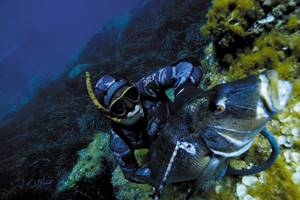
Remember that in a critical situation under water, even with a small supply of air and time, there is a way out.
If you are just thinking about taking up spearfishing, I would like to immediately point out that not everyone who can swim can do this. It is necessary to master the skills of swimming underwater with fins, a mask, and a breathing tube.
Improve the technique of involuntary breathing, as well as blowing out water poured into the tube during diving. It will take some practice before you can move silently underwater while spotting prey.
Weapon
Underwater crossbows with a bowstring made of elastic materials and guns powered by spring power, which are widespread today, came to us from abroad. Guns with a sealed barrel are popular among American hunters. It uses cartridges charged with gas or explosive under high pressure. Hydraulic and rocket guns are also common.
The standard length of the weapon ranges from 140 to 160 cm, but short samples (110-115 cm) are also produced. Such small models, as well as special pistols, are used for hunting in difficult conditions, when the shooter has to work between rocks, in grottoes, and crevices.
For long-distance shooting, as well as in cases where the target is a long fish, guns up to 2 m with a spring are effective. Typically, the design of such models involves a super-compressor.
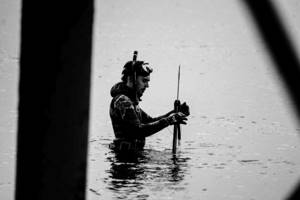
Some anglers prefer to hunt at night. They choose illuminated guns or use special flashlights.
Crossbows are designed in this way: a lightweight hook (or shoulder rest) is located in the tail, and the release mechanism and pistol-style handle are in the middle. To ensure that the gun lies more securely in the hunter’s grip, there are supporting handcuffs. It is important that the weapon is not bulky. This makes diving difficult. Sometimes air-filled pipes are installed on crossbows.
The killing distance depends on the type of gun. It ranges from one and a half to two to 6-7 m.
Mask
The mask protects the diver's eyes and allows him to see underwater without obstacles. Some models are designed in such a way that they can also provide breathing. Previously, they had a binocular shape. However, this has a detrimental effect on vision. Abroad they began to produce products equipped with a solid, most often round, viewing glass.
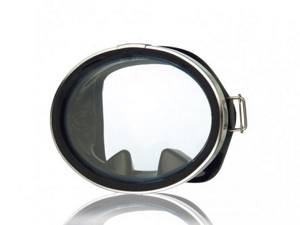
Masks with respirators are classified depending on their design:
- products in which breathing is carried out through the nose (the mouth is free);
- products where the respirator covers the mouth and nose.
The mask is equipped with one (less often two) breathing tube. It is located above the diver's head, on the surface. If two tubes are used, they are positioned on either side of the swimmer's head.
A strap is used to secure the mask. The old tubes were designed in such a way that when diving to a depth, when they sank below the surface, water filled the cavity. Today's equipment does not have this defect. A valve is installed in the tubes to block access to the respirator.
Spacesuit helmets make movements more free than when using a mask, but are prohibited in many countries due to unsafety.
Peculiarities
Depending on the body of water and the season, spearfishing has its own characteristics:
- Freshwater bodies: here it is worth inspecting the edge of the vegetation by diving close to the bottom.
- Rivers: you need to move along the current.
- Seas: hunting is carried out closer to the bottom, with some kind of shelter nearby.
- Season: Seasons also affect spearfishing.
Winter time
- The fish is mostly passive, the reaction is calmer.
- The water is clear, which increases visibility and makes finding fish easier.
- Possibility of using long crossbows, the advantage of which is the production of silent, accurate and light shots
Flaws:
- Covering the surface of the water with ice.
- Descent of fish to significant depths.
- Possibility of hypothermia.
"Equipment":
- A wetsuit should be chosen with a thickness of more than 10 mm. At minimum water temperatures, it is recommended to use thermal underwear under the suit.
- The choice of gloves or mittens should be based on a thickness of at least 5 mm.
- As for socks, they should be centimeter thick.
- The load must not exceed 15 kg.
- To prevent freezing of the face, it is recommended to choose one-piece masks with open parts for the eyes, mouth and nose.
Spring time
- Spring spearfishing is short due to snow melt and prohibition due to fish spawning.
- Considering the low water temperature, a wetsuit of 10 mm thickness is selected. Arrows with hooking limbs or guns are used, the length of which should not exceed 50 cm. In general, the equipment should correspond to its winter counterpart.
- In reservoirs with standing water, spearfishing can be limited to a depth of 1.5 meters. As a rule, hunting is mainly carried out in a vertical position. Based on this, the blades of the fins should be of medium size.
Summer time
- Summer is considered the hot season for spearfishing. Places are selected where the level of visibility is the highest, and the depth varies from 2 to 4-5 meters.
- Given the warm water, there is no particular need for a wetsuit. You can dive into the water in a T-shirt and shorts. But, nevertheless, there are varieties of suits designed for summer. Suits made in a separate style are similar. Positive visibility allows the use of guns whose length can exceed 1 m in length.
Autumn time
Autumn is characterized by fish passivity and preparation for winter. Hunting is carried out at a depth of about 3 meters. The search for fish occurs among vegetation, among snags or in depressions.
Time of day: Most spearfishing is organized during the daytime. But there are also night types of spearfishing.
Positive features:
- High probability of catching large fish.
- There are no risk factors for collision with technical navigation equipment.
- Lack of cases to interfere with fishermen fishing with rods.
- At night there is no wind, which facilitates the close movement of fish to the coastal shallows.
- Possibility to use flashlights, making tracking and hunting easier.
Negative features:
- The flashlight occupies the free hand. A constantly outstretched arm gets tired and when making shots there may be misfires if you do not support the weapon with your second hand.
- Difficulty reproducing concentration on the target due to the monotonous water background, difficult separation of fish from vegetation.
- The likelihood of entangling the ropes of the kukan, the lantern and the fish itself.
- Orientation difficulties, as a result of which there is a possibility of becoming entangled in nets, falling into underwater rubble, or ending up in the branches of flooded trees
- The equipment is “on duty”, as in all cases. But the most important things are the presence of a flashlight and a knife.
Flippers

Fins allow you to cover long distances by increasing the force of your kick in the water. Movement speed also increases. This is important because the hunter does not have much time to spend at depth. Manufacturers produce two types of “fins”:
- with a shortened sole (the heel remains bare);
- with a sole for the entire length of the foot.
Some athletes prefer not to use fins. They explain this by saying that their legs get tired from their heaviness.
Equipment
Spearfishing on a river with a gun involves staying in the water for a long time. Even in the summer months, without a special suit, you can get hypothermic. Special suits will help you avoid trouble. They will not only prevent you from getting too cold, but will also protect you from possible parasites living in the grass. There are two types of suits: dry and wet.
Dry
Neoprene suits used in cold water below 4 degrees and at great depths. They are rarely used for hunting because they have low elasticity.
Wet
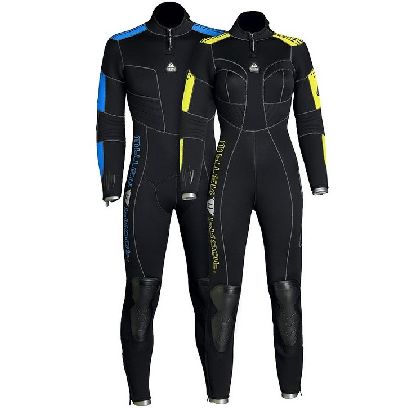
The most common suits are selected according to the figure. The thicker the neoprene fabric, the warmer the hunter.
- 2mm 28 degrees water temperature
- 3mm 21-28
- 5-6mm 18-21
- 6-7mm 12-18
- 7-9mm 4-12
- When the water temperature drops below 4 degrees, dry suits are used.
How to Prepare for a Hunt
To start classes you do not need to have any special physical characteristics. This is available to all people with healthy lungs, heart, nervous system and good vision. Women can also hunt underwater. There are many athletes abroad who have chosen this particular discipline.
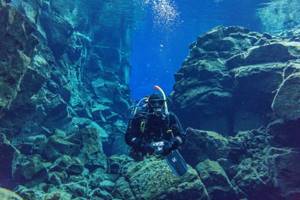
Those wishing to engage in spearfishing should familiarize themselves with the equipment and equipment. They learn to work with it. But the most important thing in hunting underwater is breathing. Many instructors begin their classes with it. The fisherman must develop a breathing rhythm with a respirator. The exercises are first carried out on land. Descent into the water is allowed only when the hunter learns to make breathing movements automatically, without concentrating on them. Otherwise, all his time at depth he will be fixated on its correctness, and not on anything else.
Training begins with learning to work with a mask on land. When the future underwater hunter has thoroughly mastered everything necessary, they move on to exercises in the water. First, the diver stands with his feet on the bottom of the pool or pond and dives headfirst. Only after this do they start swimming. The most important part of diving is diving. There are several descent methods:
- vertical;
- sloping (diagonally);
- to a shallow depth in a standing position.
The first option is necessary when the potential prey is directly under the hunter. It is advisable to be familiar with all the techniques. They are useful in reconnaissance, tracking and hitting targets.
Hunting equipment
Fins are purchased depending on the size of your feet and socks. Must have closed heel sections. For beginner underwater hunters, it is recommended to purchase fins with soft blades. It is prohibited to allow the feet to be compressed by the fins. Otherwise, your feet will freeze and cramps may occur.
Masks are an essential element of spearfishing. When choosing masks you need to pay attention to:
- Waterproof.
- No fogging.
- Maximum visibility of the water area.
The mask must provide compression of the nose due to the need to equalize pressures at increasing diving depths. When choosing a suitable mask, you definitely need to try it on.
Selecting a tube does not require much effort. Here you need to pay attention to ensure that the mouthpiece of the tube does not jump out of your mouth while breathing.
A belt with a weight is used for diving. For beginners, it is recommended to use rubber belts with lead weight pads that do not interfere with breathing. To select the right load, you need to proceed from the thickness of the suit. For example, with a suit with a thickness of up to 5 mm, the load should not exceed 8 kg. The thicker the suit, the larger the load must be applied.
Spear gun. According to their characteristics and effectiveness, there are the following types of guns:
“Crossbow” - guns equipped with rubber-based rods. For beginner spearfishing enthusiasts, it is preferable to use crossbows whose length does not exceed 70 cm. The peculiarity of crossbows is their simplicity. They are used in lake and sea reservoirs with clear water. A very effective action is performed within a radius of 4 m.
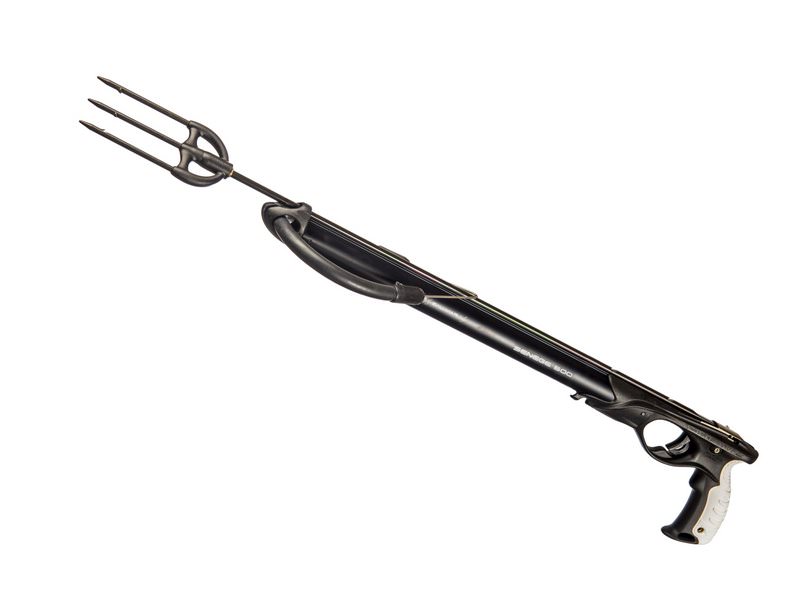
"Pneumatic" - air guns. Both types of weapons provide powerful shots. As a rule, for beginner underwater hunters it is recommended to use guns whose length reaches more than 50 cm. Such guns are easy to use, reliable and guarantee a successful hunt with a probability of up to 90%. Effectively used in almost all bodies of water. In the case of hunting in reed and stone reservoirs, the length of the weapon should be no more than 80 cm. The gun should be loaded or unloaded only in water.
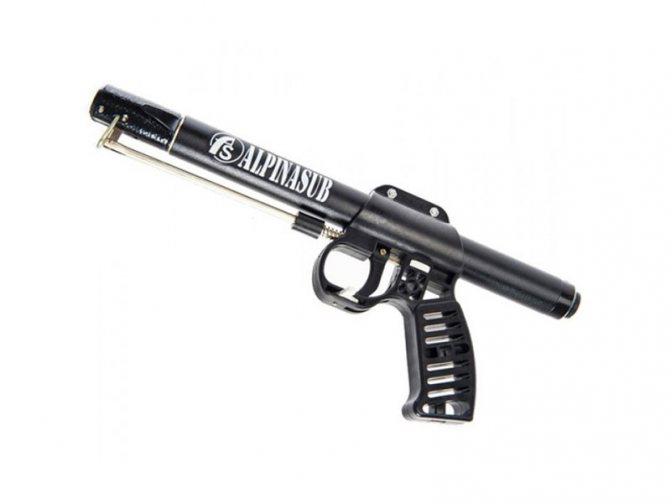
A knife is a mandatory element of equipment for an underwater hunter at all times, regardless of the characteristics of the aquatic environment and fishing. Knives with both sharp sides - stilettos - are the most recommended. The location of the knife is the inside of the shin, to prevent interference and “hooks” on the algae.

Kukan is a mandatory attribute. With its help, you can tie prey to yourself. A flashlight for underwater hunting is used in night underwater hunting, or in hunting, taking into account the depressions and caves in the topography of the reservoir.
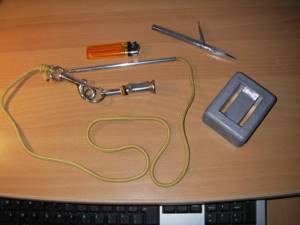
When choosing a flashlight you should pay attention to:
- Complete lack of water permeability.
- Reliability of the design.
- Working hours.
- Light power.
- Equipped with a strong cord for fastening.
Experiences of famous athletes
Dukan, Rogi and Diole are well-known foreign submariners. They recommend starting each dive with a survey of the reservoir, the purpose of which is to determine the main characteristics - coastal profile, bottom topography, depth, vegetation, presence of shoals, etc. If this is not the first time you are diving in the chosen place, the examination can be carried out more quickly or, in extreme cases, omitted altogether.
Shallow bodies of water can be explored without being completely immersed. At greater depths or low transparency, when the bottom is not visible, the hunter needs to dive to fully view it.
An inspected body of water will not only make diving safer, but will also help determine the types of fish present in it and tell you where to look for them. For example, a lot of prey is hidden in algae thickets, in rock crevices or between boulders. Some species, such as the stingray, on the contrary, lie shallow, slightly buried in the sand. To distinguish it, you have to look at the bottom for a long time. The silhouette and small black eyes give away potential prey. There's no time to waste. The hunter should, without going down to the bottom, shoot at the center of the stingray's body.
It is important to remember that each technique is effective when hunting certain species. It is necessary to study information about all the fish that live in the reservoir chosen for fishing.
The hunter's tactics are developed in accordance with the habits of the species of aquatic inhabitants. For example, according to experts from abroad, the head, lateral line organs, and the base of the tail fin are the most vulnerable places on the fish’s body. In this case, the damage from a hit in these areas will be different. A head wound is most often fatal. A hit in the spine (back) will completely or partially immobilize the prey, weaken it and not give it the opportunity to resist or attack. But it is most advisable to inflict such a blow on crabs, flat fish - flounder, stingray, etc.
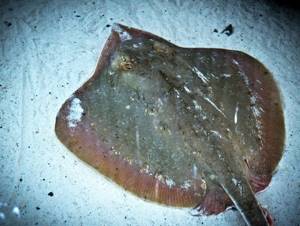
Damage to the lateral line will disrupt the fish's coordination. This is the most profitable option.
It is inconvenient to hit the fish from the front. From this angle, the “target” is small and difficult to hit.
It is rare to shoot prey in the stomach. This is only possible if the fish swims above the hunter.
You also need to take into account the firing angle. This is important, for example, when hunting carp or lobia, which have strong, large scales from which an arrow can bounce off. An angle of 45° should be maintained.
At a moving target, just like on land, they shoot ahead. In water, a hunter has more room to maneuver than on land. The fisherman, after he hits the fish, pulls up the harpoon line using a reel or hands. They do this quickly so that the escaped prey does not break or tangle the thread.
To release the spear or harpoon from the body of the fish, use a knife, making cuts in the place where the teeth of the tackle are attached. Some models are available with detachable slits. There are special “scissor arrows”. They are easier to remove from affected fish.
J. Dukan shares his experience of catching the sultana in the Mediterranean Sea, where large specimens reach 50-70 cm:
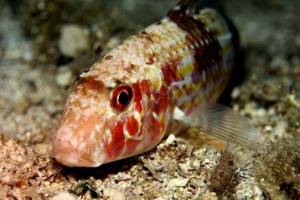
“I have found sultana at different depths. Most often it hides in algae thickets or lies on a rocky bottom. In general, you can look for it at a depth of 1.8-4.5 m. The Sultan needs to be “tamed.” She is very shy, but if you approach her slowly, it is not very difficult to catch prey. First you should just let her get used to someone else's presence, and then carefully approach closer. Sultanas are one of those fish that love to swarm in the sand. You can shoot if you catch her doing this - at this time she is serene and will not run away when she senses the approach of a hunter. The distance needs to be as short as possible.”
The dangers of spearfishing
Discipline itself is not dangerous. This shows the experience of athletes who have been actively engaged in underwater fishing for 5-10 years. Hunting requires strict adherence to established rules. If all requirements are met, the risk of an emergency situation posing a danger to life is minimal.
Factors that can lead to accidents:
- non-compliance with the physiological regime (violation of breathing rules); lack of awareness of representatives of aquatic fauna and the danger they may pose;
- unsuccessful choice of a place for hunting, unscrupulous inspection of it;
- carelessness in handling weapons.
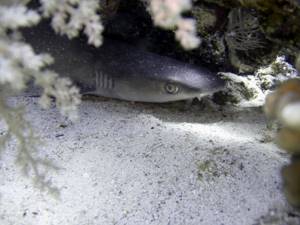
Let's look at potential dangerous situations using examples.
Beginners, ill-informed or simply careless hunters may exaggerate their capabilities. Unable to regulate their breathing, they get carried away and swim to great depths, or spend more time under water than they should. This is fraught with such dangerous health consequences as pulmonary emphysema, nose or ear bleeding, arrhythmia, convulsive contractions of the muscles of the limbs, loss of consciousness, during which oxygen does not reach the brain.
Hunters who are not familiar with the species inhabiting the chosen body of water are faced with injuries caused by certain fish or other underwater animals.
The danger is:
- stingray (sea cat) – leaves long-lasting, painful lesions;
- stinging jellyfish - the pain is similar to a burn or electric shock, allergic reactions are possible, including anaphylactic shock;
- sea ruffe (Black Sea scorpionfish) - damage by the thorn is painful, allergies and inflammation may occur;
- sea dragon - the venom of the thorns causes severe pain and is fatal in high concentrations.
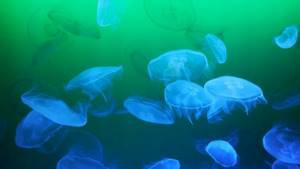
If the place is chosen incorrectly or the reservoir is not studied enough, there is a risk of falling into a cave or crevice, or getting stuck in a narrow passage between stones. Nets and various traps also pose a danger, so you should beware of places where fishing is active or where hydraulic structures are located.
It is important to handle weapons competently and carefully. On land, underwater crossbows shoot further (20-30 m or more). You must not point the gun at yourself or other people.
Sharks and octopuses pose a great danger, but they are practically never found in the waters of our country. Most stories about these species of sea inhabitants are exaggerated. Cephalopods are found in the Sea of Japan, but do not pose a danger to underwater fishermen. The octopus is a cautious, timid animal. He avoids contact with people in every possible way. At the same time, he can become prey. The mollusk should be hit in the head. This can be done not only with a harpoon, but also with a dagger.
Sharks that can be found in the waters of our country do not pose a danger to the hunter. They are found in the Black Sea and the Far East. Katranas are small in size, but have spine-like processes on their fins. This can cause injury if you are not careful. Herring sharks are larger, but also not dangerous for an experienced, careful fisherman.
Underwater hunter and photographer Hans Has spoke about his encounters with sharks. Gilbert Dukan had the opportunity to come into contact with this fish in the Mediterranean Sea. All cases ended successfully. The hunters did not show excessive interest in the sharks, and they also did not pay attention to people.
Abroad, where this dangerous fish is common, they use a special device. The device is assembled from two folding electrodes and a battery. The device creates an electric field around the diver. Waves scare away sharks. The device is small in size and fits into a belt bag.
Features of the flow
Against
In rivers with a weak current, the direction of movement of the swimmer is of great importance. Moving against the current gives you more time to look at the rubble of trees and thickets of grass in search of prey, as well as the opportunity to catch up with the fish going up.
With the flow
While swimming with the current, you have the opportunity to come across a school of bream hunting asp and pike perch in the water column.
Dwelling
Hauling can be done in the rubble of trees or grass by grabbing a tree branch or any other object at the bottom with one hand. A curious fish must come within shooting range.
Conditions for spearfishing in the territory of the former USSR
Suitable for underwater hunting are sea coasts and inland waters. Valuable species of fish are found in their depths. But spearfishing is not always and not possible everywhere. It largely depends on weather conditions, as well as other factors. Water transparency is also important, determining visibility and temperature conditions, which fluctuate throughout the year.
Most often, bodies of water that are suitable for swimming in warm weather are also suitable for spearfishing. Safety is also an important criterion. According to medical standards, the temperature for swimming should be at least 18°C. In summer, most reservoirs in the middle zone and in the South warm up sufficiently.
The duration of the “warm” period depends on geographic latitude. In some places the hunting season coincides with the swimming season, in other places it lasts much less. For example, on the shores of the Black Sea, underwater fishing can be practiced from mid-May to early October, but in the Moscow region only 2-3 months in the summer. This depends on the heating characteristics of the reservoir. For divers, it is important that the temperature at the desired depth is acceptable. In lakes and artificial reservoirs, only the upper layer warms up; the difference with the lower layer can be several degrees. It is called the “temperature jump layer.” The higher it lies to the surface, the more difficult it is to spearfish. Therefore, the development of the discipline is moving slowly in inland waters. The Baltic Sea, since it is inland, also poses certain difficulties.
Transparency is another important criterion for assessing the suitability of a reservoir for spearfishing. The swimmer must see the bottom and the space around him as clearly as possible. Transparency depends on the content of foreign particles in the water. This indicator determines the area and depth of hunting areas.
During rains or storms, coastal runoff increases and transparency becomes lower. Due to strong currents, some rivers are also insufficient for underwater fishing. The transparency of phyto- and zooplankton, flowering or death of plants is affected.
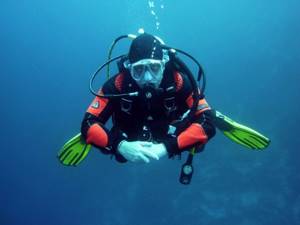
The indicator is determined by immersing a white disk (diameter up to 30 cm) to a depth. The limit of its visibility is the transparency value of a particular body of water. That is, if it is equal to 6, this means that a disk lowered below 6 m is not noticeable from the surface. The Mediterranean Sea is characterized by high transparency. In different areas it ranges from 20 to 60 meters. The extreme limit of the transparency indicator for some inland water bodies in the territory of the former USSR:
- Terletskoye Lake – 22 m;
- lake Turgoyak – 12 m;
- lake Pereyaslavskoe - 8.5 m;
- Valadaiskoe lake – 5.5 m;
- Seliger - 3.5.
Low visibility is observed in the lake near Moscow. White - up to 0.8 m. The transparency of the Black Sea waters reaches 20-30 m. The Aral Sea is characterized by 24 m. The Sea of Japan is also characterized by good visibility. It is suitable for underwater fishing, despite the fact that the indicator decreases towards the shore. The transparency of the Azov and Caspian seas is low. Despite this, they are quite comfortable for diving and hunting.
Required equipment and its description
Mask
Without a good mask, spearfishing will not work, it will be difficult for you to see the target and then hit it.
A high-quality mask for underwater hunting should fit tightly, but not squeeze your head. If the mask is not fitted correctly, you will feel a headache from the compression. The mask should be checked this way: place it on your face and suck in air through your nose.
It should stick and last for a while. We take into account the review of the mask - as much as possible. The black color of the silicone will protect from sun glare.
A tube
It’s also unthinkable to fully hunt without a snorkel; you won’t be able to stay underwater for long without breathing.
A beginner can get by at first with a not very expensive model, including one for diving. You should not use a tube with silicone corrugation, as it will make noise, which will scare the fish. A good solution is a corrugated, flexible tube on top and a flat, smooth surface on the inside.
The smooth surface will allow water to escape, which will prevent noise, and the corrugation will provide flexibility, which will prevent injury to the mouth from the mouthpiece. The option with an existing top valve is welcome. The top valve will suit any design.
Flippers
Fins serve as the swimmer’s “motor”; being in the water, equipped with weights and weapons, it is not easy to move quickly. The choice of fins is determined by the hunting location, factors such as diving depth and openness of the area are taken into account. Fins for hunting vary in blade size and material.
The galoshes are usually rubber, the blades are plastic or plastic. Stiffness also varies. Optimally, the fins are medium, not too hard, allowing you to maneuver in the water with penetration into thickets of plants. Long fins will make it difficult to move in shallow water with snags, and there is a risk of damaging your legs and fins.
Are you planning to hunt in deep water and in open space? You should choose long, hard fins. They will give you speed in deep sea diving. This option is more suitable for experienced hunters.
There are fins with replaceable blades. They suggest replacing the blade due to wear, breakage, or replacing it with a different shape. An excellent option for fins without a back. It is convenient that the foot fits in socks of different thicknesses.
After you purchase diving socks, when purchasing fins, you should try on this equipment together; as a rule, stores are equipped with showers for the convenience of customers. Properly purchased fins will successfully complement the catch equipment and improve maneuverability.
Gun
The type of place in which you intend to hunt will help determine whether you have a pneumatic or crossbow gun. If it is the sea, and also if it is not possible to swim close to the target, then a crossbow will do. An air gun will be indispensable in less transparent water, in thickets of reeds.
Costume
There are many options for a wetsuit for a comfortable dive. It is recommended to choose a suit consisting of a jacket and overalls. These items are sold separately, taking into account the discrepancy between the same jacket and pants sizes.
For summer, a suit with 5 mm neoprene is suitable, but a warmer version with a thickness of 7 mm is even warmer than 9 mm. In autumn and spring, the transparency of the water is greater, so hunting is the most exciting, therefore, the suit should be selected according to the external temperature.
The size of a wetsuit is considered appropriate if it does not compress the body and does not hang on the hunter. Often, stores offer to try on a suit directly at their place or with the option of returning it and trying it on at home in the shower. It is important not to make a mistake with the size, otherwise the hunter will freeze.
The most comfortable thickness of neoprene socks is 7 mm, 9 mm is also an excellent solution. Gloves come in five-fingered and three-fingered gloves; five-fingered ones are more comfortable, but they are thinner; in cold water the hands cool down faster.
The weight belt is selected taking into account body weight and the thickness of the wetsuit. It should merge with the body and not sag. The amount of weights can be adjusted. To prevent water from pushing out, a swimmer weighing 100 kg should be weighed by 10-12 kg, taking into account if his suit is 7 mm thick neoprene.
In order not to return to the shore or boat with a trophy every time, an underwater hunter needs a fish kukan. From a variety of options, this accessory can be selected as desired.
Knife
A very important thing in a hunter's equipment. If you forget your knife, the dive is cancelled. A knife is your safety in water. Main characteristics when choosing: reliability, functionality, convenience. It is better to attach it on the thigh.
You should consider a convenient fastening; in case of danger, the knife should be easily removed, the fastenings should not cling and interfere with movement.
Of course, this is not a mandatory list of equipment; each hunter individually selects hunting accessories for himself, according to weather and geographical conditions.
Optimal conditions for underwater fishing
The conditions of the Black Sea remain the most favorable - clear water, warm southern sun. Athletes will be interested in the rich fauna and flora - about 167 species of fish live in the depths.
The temperature allows hunting up to 5 months a year. The water warms up best in August. Average for different parts of the coast:
- Batumi – 24.4°C;
- Kerch Strait – 23.3°C;
- Crimean peninsula (southern coast) – from 22.2 to 23.2°C;
- Cape Tarkhankut (West of Crimea) – 22.8°C;
- Dnieper Estuary – 22.2°C;
- Odessa – 21.6°C.
Along the shore, among the rocks, stones and algae, a variety of fish are hidden. Such areas for the hunter become real places of “unafraid game.” Prey can be species with telling names - quail, hazel grouse or other representatives of the wrasse species.
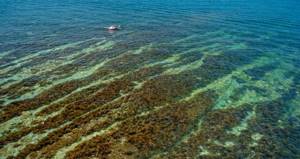
Underwater fishermen of the Black Sea region can expect frequent encounters with crucian carp, ruffe, mullet, garfish, and trigla. There are also large individuals that reach more impressive sizes:
- light (samples over 1 m and 32 kg were found) and dark croaker (50 cm, 3-4 kg);
- flounder-kalkan (up to 15 kg);
- sole;
- Katran shark (up to one and a half meters);
- beluga (up to 3-4 m);
- sturgeon (up to 2 m);
- spiny stingray (length up to 1 m) and stingray (up to 1.5 m), etc.
Flounders and rays preferentially bury themselves in the sand. The latter, as dangerous predators, ambush small species of bottom fish.
Off the coast you can see large schools of mackerel, bonito, horse mackerel, and less often tuna. The latter can sometimes reach up to 3 m and 600 kg. Catching tuna is a rare practice for underwater fishermen.
Sturgeon will become a valuable trophy:
- stellate sturgeon;
- thorn;
- beluga;
- sturgeon.
However, hunting these fish is not very encouraged. It would be better to ban this practice. Even during commercial fishing, population indicators are taken into account. In addition, the state is carrying out complex work on the artificial reproduction and population of reservoirs with these breeds. It would be reasonable to take this point into account when drawing up a set of rules and recommendations for spearfishing.
In addition to fish, the Black Sea will delight the diver with large breeds of crabs. He will have the opportunity to watch or even swim with dolphins. You can see the shell of a large mollusk – rapana.
Be aware of the possible danger. Most emergencies arise due to lack of awareness and knowledge of the rules of behavior when encountering dangerous species. For example, at the bottom you can see a sea dragon. This is a small fish (up to 30 cm) with poisonous spines on the gills and fins. A sea dragon buries itself in the sand. He may attack if disturbed.
The scorpionfish, known as the sea ruffe, is also poisonous. A dangerous substance is released by a solid ray located on the fin of the back.
Occasionally in summer, a single swordtail may enter the Black and Azov Seas. Cases have been witnessed of the fish damaging light boats and even more durable oak hulls covered with sheets of copper with its long bony appendage. The swordfish can move at a speed of close to 100 km/h, so it is extremely dangerous for humans.
Other "fishing spots"
Those who find themselves near Vladivostok are recommended to visit the shores of the Sea of Japan. These are picturesque places with rich fauna. Among the rocks and thickets hide starfish and urchins, sea cucumbers (sea cucumbers), swimming crabs, spiny crabs, as well as herring sharks, stingrays, octopuses and other unusual species. Suitable fish for hunting include Japanese ruffe, tuna, mackerel, yaok (goby), and flounder. There are armored species, for example, Agonmala.
Good conditions of the Azov, Aral and Caspian seas allow active underwater fishing for a long time. Among the valuable species, the following types are distinguished:
- bream;
- zander;
- carp;
- some sturgeon.
Azov is famous for mullet, gobies of various types, garfish, flounder, etc. Closer to the southern coast there are mackerel, bonito, and sometimes tuna. Sometimes you can admire dolphins.
The specifics of the Caspian Sea make it possible to meet pike and catfish in its desalinated areas. Due to the fact that there is enough space and resources for growth, giant specimens are encountered. At the depths of the Caspian Sea, fisherman will find such trophies as mullet, herring, and gobies. Perhaps you will be able to admire the seals.
The clear waters of the Aral Sea are very convenient for practice. The hunter will learn to scout and observe potential prey.
Features of river hunting
Varies by time of year
- summer
- winter
By day
- daytime
- night
Summer
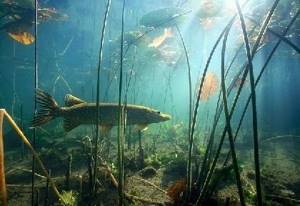
During the daytime in summer, trophy catfish, pike, and pike perch lie in pits, hiding from direct sunlight.
The night search for predatory fish is simplified by the fact that almost all of them, having rested during the day, rush to shallow water for small change. The exceptions are species that rely on sight for hunting: perch, ide, and asp.
Fishing on small rivers with depths and visibility of 3-4 meters, can be of three types.
- With the flow, it requires the hunter to be attentive and quick to react.
- Against the flow, in addition to the first two qualities, there is also strength.
- Laying down requires patience.
Prospects
The catch of a fisherman operating underwater is often larger. Even when there is a “calm” in the reservoir and there is no bite, in the depths of lakes, seas, rivers or ponds you can always find pike, ide, bream, perch or tench. In addition, such experience is useful and interesting.
Some people believe that this sport is expensive. This is wrong. Among foreign professionals and amateurs there are many ordinary workers, students or artists.
If government organizations take over the spread of the sport. The Komsomol undoubtedly plays a big role in this. The development and production of basic equipment and auxiliary equipment (waterproof cameras, depth meters) is actively underway. Particular attention is paid to safety. Life jackets and shoulder pads are produced that are inflated with carbon dioxide during emergencies. The procedure for athletes to undergo medical examinations is being discussed. It would be advisable to introduce a special periodically renewed ticket giving the right to spearfishing.
Equipment requirements
Amateurs and professionals of this extreme sport clearly state that the requirements for equipment for spearfishing are the highest.
Gloves, socks, and a wetsuit must fit properly and be tight enough not to squeeze.
They must be waterproof and maintain a comfortable temperature. The mask is selected individually for each person; it must be made of high-quality materials, fit tightly to the face, and not allow water to pass through.
Fins are selected according to the size of the foot plus the toe.
The weapon is selected according to the hunter's hand. The length, power, and features of the reservoir where hunting is expected are taken into account.
It is not necessary to buy branded and expensive underwater equipment; it is important that it is practical and fulfills its characteristics one hundred percent. Accordingly, we must take into account that high-quality equipment is not cheap. You should not skimp on your own safety.
